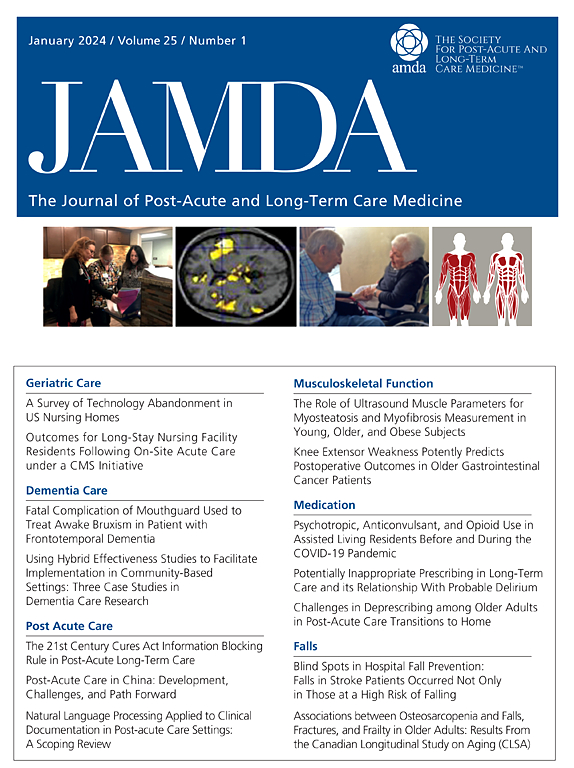中国养老院老年人久坐行为的机制:能力、机会、动机-行为模型导向的结构方程模型。
IF 4.2
2区 医学
Q2 GERIATRICS & GERONTOLOGY
Journal of the American Medical Directors Association
Pub Date : 2025-06-05
DOI:10.1016/j.jamda.2025.105629
引用次数: 0
摘要
目的:基于能力、机会和行为动机(COM-B)模型,对养老院老年人的久坐行为进行评价,探讨久坐行为的潜在机制。设计:横断面研究。环境和参与者:我们收集了来自中国11家养老院的329名居民的数据。方法:收集居民人口统计、久坐行为、日常生活活动(ADLs)、社会支持、运动自我效能感和抑郁症状的自我报告调查数据。使用平均值和标准偏差来描述养老院中老年人的久坐行为。我们利用COM-B模型,构建了一个结构方程模型来评估adl、社会支持、运动自我效能、抑郁症状和久坐行为的相互关系。结果:在我们的样本中,老年人平均每天久坐的时间为11.4小时(SD = 2.6)。社会支持不仅直接影响养老院老年人的久坐行为(β = 0.042;P = 0.039;95% CI, -0.054至-0.031]),但也间接通过运动自我效能感(β = 0.003;P < .001;95% CI, -0.023至-0.011])和抑郁症状(β = 0.003;P < .001;95% CI, -0.018至-0.006)影响久坐行为。ADLs通过运动自我效能间接影响久坐行为(β = 0.029;P < .001;95% CI, -0.220至-0.107)和抑郁症状(β = 0.099;P < .001;95% CI, -0.161 ~ -0.053)。结论和启示:在我们的居民样本中,高水平的久坐行为值得长期护理人员和管理人员意识到。减少久坐行为的潜在策略包括促进社会支持、增强运动自我效能和控制抑郁症状。本文章由计算机程序翻译,如有差异,请以英文原文为准。
Mechanisms Leading to Sedentary Behaviors among Older Adults in Chinese Residential Care Homes: The Capability, Opportunity, Motivation-Behavior Model Guided Structural Equation Modeling
Objective
To evaluate sedentary behaviors among older adults in residential care homes and explore potential mechanisms leading to sedentary behaviors based on the Capability, Opportunity, and Motivation to Behavior (COM-B) model.
Design
Cross-sectional study.
Setting and Participants
We collected data from 329 residents who lived in 11 residential care homes in China.
Method
We collected self-reported survey data on resident demographics, sedentary behavior, activities of daily living (ADLs), social support, exercise self-efficacy, and depressive symptoms. Mean and standard deviation were used to describe the sedentary behavior of older adults in care homes. We drew on the COM-B model and constructed a structural equation model to assess the interrelationships of ADLs, social support, exercise self-efficacy, depressive symptoms, and sedentary behavior.
Result
The average daily sedentary time of older adults in our sample was 11.4 hours (SD = 2.6). Social support not only directly influenced sedentary behavior of older adults in care homes (β = 0.042; P = .039; 95% CI, −0.054 to −0.031]), but also indirectly through exercise self-efficacy (β = 0.003; P < .001; 95% CI, −0.023 to −0.011]) and depressive symptoms (β = 0.003; P < .001; 95% CI, −0.018 to −0.006) affected sedentary behaviors. ADLs indirectly affected sedentary behaviors through exercise self-efficacy (β = 0.029; P < .001; 95% CI, −0.220 to −0.107) and depressive symptoms (β = 0.099; P < .001; 95% CI, −0.161 to −0.053).
Conclusions and Implications
The high levels of sedentary behaviors among our sample of residents warrant awareness among long-term care staff and managers. Potential strategies for reducing sedentary behaviors include promoting social support, enhancing exercise self-efficacy, and managing depressive symptoms.
求助全文
通过发布文献求助,成功后即可免费获取论文全文。
去求助
来源期刊
CiteScore
11.10
自引率
6.60%
发文量
472
审稿时长
44 days
期刊介绍:
JAMDA, the official journal of AMDA - The Society for Post-Acute and Long-Term Care Medicine, is a leading peer-reviewed publication that offers practical information and research geared towards healthcare professionals in the post-acute and long-term care fields. It is also a valuable resource for policy-makers, organizational leaders, educators, and advocates.
The journal provides essential information for various healthcare professionals such as medical directors, attending physicians, nurses, consultant pharmacists, geriatric psychiatrists, nurse practitioners, physician assistants, physical and occupational therapists, social workers, and others involved in providing, overseeing, and promoting quality

 求助内容:
求助内容: 应助结果提醒方式:
应助结果提醒方式:


